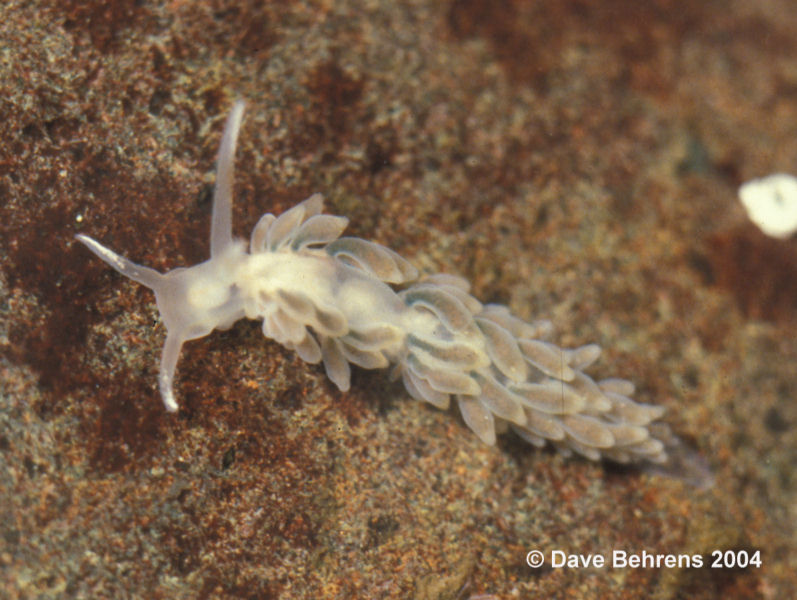 |
Catriona rickettsi
Photo courtesy of Dave BehrensCatriona rickettsi Behrens 1984
Discovering a species new to science is incredibly exciting, indeed. Choosing a name for the new species is a very special event for a scientist, especially when such a prestigious description is one of your first and the animal was discovered right in your backyard. When this happened to me, as a young fledgling biologist, selection of an appropriate name was paramount. I wanted to recognize a local hero, a person who had left an impact not only on California, but on me also.
The naming protocols for new species of plants and animals are carefully regulated by international nomenclatural organizations. Still, scientists have a great deal of leeway in the selection of names. I have seen new species named for their color or a particular physical feature, but also the place they were discovered, boats, political figures, wives and children (I became guilty of this more recently) and even family pets and mythological animals. Some species names are combinations of names making for a real tongue twister.
While attending graduate school in northern California I had spent countless hours searching for and studying the tide pool creatures of the Monterey peninsula. Each trip began with a ceremonial drive down Cannery Row, to give reverence to the weathered wooden shrine which was once the home of Pacific Biological Laboratories. Walking on many quiet, foggy mornings, knee deep in the tide pools along the Seventeen Mile Drive I was almost certain I could hear the creative discourse between two local philosophers, two men who could and would pause while plucking sea stars out of crevices, to banter on topics, later to be dubbed "non-teleological thinking."
When two newly discovered species of nudibranch, a marine mollusk sometimes referred to as a sea slug, came to my attention I couldn't help but think that the names of my two mentors, John Steinbeck and Edward "Doc" Ricketts, were individuals who met my criteria for such a new discovery. How perfect - all four might have actually walked (or crawled) together years ago, in the same tide pools?
The impact of John Steinbeck and Edward Ricketts on the Monterey peninsula, California and the world may be immeasurable. These two remarkable individuals experienced the scenes, sounds and smells of the peninsula from 1930 to 1948 and created a magical almost mythical history that has lasted until today and will surely live on into perpetuity. Scholars still speculate on just what these two might have done and where they would have taken us had Doc lived longer. I have even heard that Steinbeck was considering a change of career, to marine biology, just before Doc died. Had this happened what might this dynamic duo accomplished? Would "Between Pacific Tides" have been a jointly authored work? Would Steinbeck have written "Travels With Charlie" at all? Who knows?
Some of us just can't get enough of Steinbeck and Doc. An expedition to follow the foot steps of their epic "Sea Of Cortez" expedition is soon to set sail. Participants hope to experience many of the same discoveries and memorable scenes that Steinbeck, Ricketts and their guests did on their voyage in 1940 aboard The Western Flyer. Many stories and contrary legends follow the original voyage, but no one can deny the enjoyment we have had from the writings that followed.
Doc was immortalized as several different characters in Steinbeck's writings: Doc in Cannery Row and Sweet Thursday, Doc Burton in In Dubious Battle, Casy in The Grapes of Wrath and Doctor Winter in The Moon is Down. Ricketts' legacy was also set in his writing of Between Pacific Tides.
While Eubranchus steinbecki (named in 1987) is the only animal species named after John, that I am aware of, Catriona rickettsi (named in 1984) was not the first species recognizing the scientific contributions of Doc. Years before I found myself dissecting these tiny nudibranchs, Professor W. L. Schmitt named a fascinating tiny sea spider or pycnogonid, Pycnogonum rickettsi. Apparently we both felt strongly about acknowledgement of the hard work and dedication of biologist, Ricketts.
This species is known from San Francisco Bay and La Jolla, California. Large numbers of this species have also been found on large patches of Tubularia sp. on the ocean side of the south jetty, Umpqua River, Douglas County, Oregon, during February 1994, 1996 and 1997. Also, Bertsch et al. (2000) extended the range south to Punta Eugenia, Baja California, Mexico.
As surprising as it may seem new species are still being discovered right here along the California coast. Finding just the right name will continue to be a challenge, particularly as the really great names seem to be all ready taken.
Danville, Calif
Jan 2004
Taxonomic information courtesy of:

David W. Behrens
Author:
Pacific Coast Nudibranchs
Send Dave mail at dave@seachallengers.com
|
